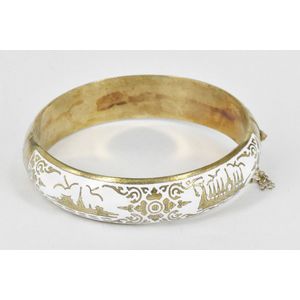Neoclassical Barr Worcester Tea Cup & Saucer, 1810
You must be a subscriber, and be logged in to view price and dealer details.
Subscribe Now to view actual auction price for this item
When you subscribe, you have the option of setting the currency in which to display prices to $Au, $US, $NZ or Stg.
- Chevron Motif - In jewellery, a chevron is a V-shaped pattern or design that is often used to create a bold and striking visual effect, and as a symbol of strength, power and protection.. It is a classic motif used in many different styles of jewellery and can be seen in various forms such as on a ring, earrings, bracelets, and necklaces. It can be created with precious or semi-precious stones, pearls, or enamel. It can be found in different forms such as engraved or inlaid or beaded.
In ceramics the pattern is often used in decorative pottery and porcelain pieces, such as vases, bowls, plates and figurines. The chevron pattern can be created by using different colored glazes or by hand-painting the design onto the piece. It is also commonly found in the form of embossing or intaglio in decorative ceramic objects. This pattern can be seen as a popular design choice in Art Deco and Art Nouveau style of ceramics.
This chevron pattern can also be found in many different types of furniture, such as tables, chairs, chests of drawers, and cabinets. A common place to find chevron pattern is in a herringbone pattern, which is made up of repeating V-shaped patterns. The chevron pattern can be created by using different types of wood, inlaying or by using different colors of stain. It is also commonly found in the form of a veneer. This pattern can be seen as a popular design choice in mid-century modern, Art Deco, and contemporary style furniture. - Circa - A Latin term meaning 'about', often used in the antique trade to give an approximate date for the piece, usually considered to be five years on either side of the circa year. Thus, circa 1900 means the piece was made about 1900, probably between 1895 and 1905. The expression is sometimes abbreviated to c.1900.
This item has been included into following indexes:
Visually similar items

A Carlton Ware 'Egyptian Fan' coffee service for six, 1932-1933, pattern 3696, design attributed to Violet Elmer. The petite coffee cans jewelled and gilded with stylised arc shaped fans flanked by towers of hollyhock style flowers and other spiral and cir

A Royal Worcester coffee can and saucer, 1883, pattern 348, with densely patterned brown and cream floral borders between gilt bands; backstamps, registration marks, pattern numbers and other marks underside, height 6.5 cm, diameter 11.5 cm

A Royal Vienna demitasse cup and saucer, 19th century, with decoration by Neumann. The trumpet shaped cup with a high mounted scroll handle, a gilded interior and handpainted with an allegorical scene within a jewelled frame upon a bleu-de-roi ground with

A Siam sterling silver bracelet, with enamel inset. Diameter 65 mm. Weight 30.6g.
